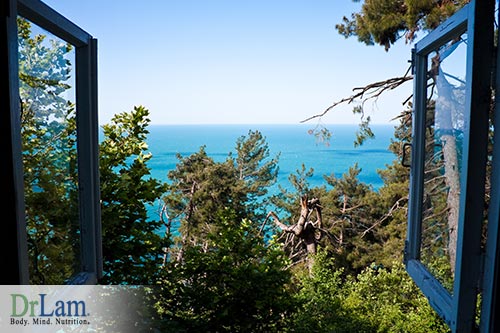 Our modern lifestyles differ greatly from what they did just fifty or one hundred years ago. It seems as though we find ourselves constantly surrounded by concrete, cooped up in office buildings, and not doing much else except sitting in chairs. This type of continued lack of exposure to nature is causing some experts to ask the question of how it may be impacting our health. This brings us to the question: what is nature deficit disorder?
Our modern lifestyles differ greatly from what they did just fifty or one hundred years ago. It seems as though we find ourselves constantly surrounded by concrete, cooped up in office buildings, and not doing much else except sitting in chairs. This type of continued lack of exposure to nature is causing some experts to ask the question of how it may be impacting our health. This brings us to the question: what is nature deficit disorder?
This term was coined by a researcher named Richard Louv in his 2005 book Last Child in the Wood. He asserts that the term is not meant to be considered a medical issue but rather an effect that is seen from modern living. He also described it as the alienation that many humans now have from the natural world. This is an interesting topic because he postulates that because children and adults spend less time outdoors, there is a higher rate of behavioral and mental issues that arise.
It’s true that people are spending less and less time outdoors. All you have to do is observe how much time adults spend in front of computer screens during work only to come home and sit in front of a television screen for hours before they go to sleep. Many of us are guilty of this but there may be farther reaching effects that encompass more of our health than we care to admit.
A somewhat frightening statistic that came out recently is that, according to a Nielsen Company Audience Report, the average American devotes ten hours and thirty-nine minutes each day looking at a screen. There is so much consumption of media that people don’t even have time to look at what’s around them. When looked at from this perspective, it’s not difficult to see why someone would raise awareness as to what nature deficit disorder is.
There is a large segment of the population that works behind desks these days. When you think about the progression of what could be considered an average day, there really is a lot of sitting down. Many people get out of bed, get ready to go to work, and maybe eat a little breakfast to start their days. From that point, they sit in a car to drive to an office where they again sit down for much of the remaining work day. This type of behavior becomes exhausting even though it doesn’t provide the body with enough activity to maintain health.
Once we get home from a long day at the office, we’re usually tired and sit down to watch some TV before bed. Are you seeing the trend here? There isn’t really any time that is spent moving around. Our minds are going a mile a minute, but our bodies aren’t doing much of anything at all. The purpose here isn’t to bore you with statistics but the average American sits for eleven hours per day. That’s a lot of sitting when you consider the fact that sleeping takes about seven hours. That only leaves you with six hours when you’re not sitting or sleeping.
The contribution that these types of habits have to our health is astounding. Not only are we disconnected from nature more than ever, it’s almost as if we’re disconnected from our bodies because we barely use them anymore. Some people don’t have a choice and there isn’t always an option to control your work environment to suit your physical needs so that means the extra time out of the office needs to be used as wisely as possible to recover what is lost.
 We’ve never been more disconnected from the natural world around us as we are in the modern age. When the most interaction you have with nature comes from the Discovery Channel then you need to ask yourself what you can change.
We’ve never been more disconnected from the natural world around us as we are in the modern age. When the most interaction you have with nature comes from the Discovery Channel then you need to ask yourself what you can change.
During most of human history, our evolution and adaptation revolved around being outside as hunters and gatherers. Only recently have we changed to spending most of our time inside. Seventy-five percent of the U.S. population lives in urban areas, limiting exposure to the natural environments that we are adapted to.
Nature deficit disorder is also associated with an increased fear and phobia of the outdoors, decreased ability to cope with stress, and decreased self-esteem. All of these things are clearly better to limit when possible – which is why it’s best to get back to nature if you can.
Bringing plants into your workspace can be a good start, especially when you are secluded from a natural setting at your job. Aside from allergies which do affect some people, there are plants which will survive even the cruelest owners so there is something that you will be able to keep alive at the office. It doesn’t need to be something that you take to the extreme, just a plant or two at your desk can promote a calming effect when working long hours away from the outdoors.
Aside from something at the workplace, there are many of us that do not live too far from proper outdoor areas that are full of plant life. This is not a suggestion that everyone goes camping to return to nature but that is definitely not discouraged. If you manage to get outside and take a walk through a park or, better yet, through a forest near where you live, it will do wonders for your emotional and physical well-being.
The stimulation of seeing things in an uncontrolled environment is therapeutic and relaxing. There have been studies that show how spending time in nature actually allows the prefrontal cortex of the brain to relax and seemingly rest a bit. The prefrontal cortex is the portion of the brain that is basically the command center, having a large impact on conceptual thinking and attention. What nature deficit disorder is doing over time disallows cognitive relaxation which results in tiredness and brain fog.
It has been largely accepted by psychologists that the amount of attention and concentration capacity we have at our disposal is not endless. Throughout the day these levels slowly deplete as we go about our work and other tasks that demand our cognitive attention.
There are two separate types of attention which our brains engage in, the first being directed attention. When we are using directed attention, we are focusing on the processing of specific stimuli while at the same time filtering out other surrounding physical and emotional distractions. As we go through this from the moment we get in the car to go to work and then all day until we arrive back at home, it becomes exhausting to the brain.
 The second type of attention is referred to as effortless attention. This type of attention is what we experience when we are looking at a sunset or beautiful scenery. Even though there are still stimuli passing in front of us in the form of birds, or other wildlife, it comes in a non-threatening form. This has a restorative effect on the parts of the brain which are drained during directed attention. This recharge is necessary to combat the effects of what nature deficit disorder is doing to the brain in an ongoing fashion.
The second type of attention is referred to as effortless attention. This type of attention is what we experience when we are looking at a sunset or beautiful scenery. Even though there are still stimuli passing in front of us in the form of birds, or other wildlife, it comes in a non-threatening form. This has a restorative effect on the parts of the brain which are drained during directed attention. This recharge is necessary to combat the effects of what nature deficit disorder is doing to the brain in an ongoing fashion.
An example of the therapeutic aspects of exposure to nature and combating nature deficit disorder is what was shown by Stanford researcher Gregory Bratman when he examined nursing home patients. During the observations, nursing home residents who were suffering from dementia showed improved mobility after spending time in a garden. Interestingly enough; even hospital patients who had green views from their rooms also experienced faster recovery from surgeries. This mental improvement is astounding because of the fact that it seems to transform into physical improvement as well. There doesn’t seem to be any replacement for the introduction of natural scenery when considered in the mental health perspective.
It doesn’t have to be someone who is recovering from surgery or suffering from dementia that needs nature to recover. Every day we are exposed to different situations and stimuli that break us down, physically and mentally. The reason to draw attention to what nature deficit disorder is doing to us is so that we can understand how far-reaching its effects are. People who live within a half mile of green space are less likely to experience anxiety, heart problems, asthma, migraines, and other negative afflictions. What is rarely considered is how much the problems which arise in our minds affect our bodies. Anxiety has very large health implications when examined through a clinical perspective.
There is a large and complex network that takes control when we are exposed to stressful situations. This network is known as the NeuroEndoMetabolic (NEM) Stress Response. This response is directly related to what nature deficit disorder is and how it affects us. Let’s begin by focusing on the neuroendocrine aspects of this response in the hypothalamus at the base of the brain. This is primarily handled through hormonal regulation. This hormonal response is mostly handled by the adrenals, thyroid, and reproductive glands. The Hypothalamic-Pituitary-Adrenal (HPA) hormonal axis is the workhorse of stress communication throughout the body.
The primary stress hormone is cortisol which is produced by the adrenal glands, located on top of the kidneys. This is the direct catalyst which drives the physical response to stress. There is also a substantial response from the thyroid gland which controls the speed at which the process takes place. Over time, these hormonal processes can become disrupted when the body is exposed to excessive stress and fatigue, often caused by both sedentary lifestyles and nature deficit disorder.
When, as discussed earlier, a person is disconnected from a natural environment for a long period of time, the healing effects of nature are not able to take effect and help the body to relax. It is in situations like these where people become fatigued and begin to feel the exhaustion of life stress without reprieve.
During times of stress and disconnection from the natural world, the body will eventually become so weary from combating stress and anxiety that it will develop Adrenal Fatigue (AF). Since the adrenal glands are the workhorse of the NEM Stress Response, they end up getting the worst of it when it comes to the demand placed on them. There can be many causes of AF including lack of sleep, anxiety, chronic inflammation, and others but here we will focus on what nature deficit disorder is doing to trigger it.
Because there is not enough time to let the brain relax and reset in an individual who is experiencing nature deficit disorder, there is a high likelihood that it could cause that same person to fall into the throes of AF. It all begins to tie together because those same effects that you are feeling due to your disconnection with nature can also cause you to feel so poorly that you don’t want to make any changes in order to return to the environment that will help you.
Once the negative cycle of AF takes hold, your body will begin to weaken immunologically, have high levels of inflammation, feel lethargic, and can trigger even more anxiety and stress because you can’t get everything done that you needed to in the first place. This only serves to reinforce the pattern that will keep you down. Once stress lowers the ability of the body to fight back, it’s easy to see how people succumb to the negativity and avoid reintroduction to the outdoors.
It is one thing to adapt to a new environment, a concrete jungle of sorts, but it is quite different to completely abandon the therapeutic natural environment that gives so much peace and joy that we all need. Spending a little time in a green space doesn’t have to be a burden or exercise; you can simply sit down and relax to help your mind recover a bit from daily life. Refusing to take any time to admire and welcome our natural environments is likely to cause our bodies to become overrun and could easily be a cause of AF.
It needs to be mentioned that there are many causes of AF and just because you think it may be your lack of exposure to nature doesn’t mean that’s the case. Your issues might be broader than that of what nature deficit disorder is adding. If you think you are suffering from severe AF it is important to contact your healthcare practitioner and ensure that there isn’t anything else going on. Ignoring problems with your health can have consequences but being aware and proactive is always a good thing. Lastly, be sure to notice how your body is reacting to any changes that you make to be positive and that you’re acting safely and within proper guidelines of wellness.
 Beyond covering all of the different things to be worried about and negative effects of disconnecting from nature, now it’s time to talk about how to use all of it to your advantage. There is much to be learned from those who take time for themselves to allow for mental and physical healing. A large portion of our culture has thrown away those tenants in favor of the nonstop hustle.
Beyond covering all of the different things to be worried about and negative effects of disconnecting from nature, now it’s time to talk about how to use all of it to your advantage. There is much to be learned from those who take time for themselves to allow for mental and physical healing. A large portion of our culture has thrown away those tenants in favor of the nonstop hustle.
A great way to limit the effects of the NEM Stress Response is to allow for time that is allotted specifically for relaxation. This can be difficult for some who like to be on the move. However, a quick stroll in your local park or a walk through the woods can do a great deal to ease your mind. When you can help relieve the burden on your brain that continued directed attention causes, you will allow for a reset of some processes. This is why the old adages of “take a walk” or “go play outside” have some ring of truth to them. It is genuinely relaxing to be outside.
Once you embrace this time to relax outside, your cortisol levels will naturally begin to drop which will ease some of the burden on the adrenal glands as they won’t have to produce as heavily. In turn, this will lower your blood pressure, inflammation levels, and even improve your absorption in the gut. This will allow you to feel more refreshed and boost energy levels. A common complaint of those suffering from AFS is that they are continually exhausted and drained. Anything you can do to limit these types of issues should be welcomed with open arms as we all know how difficult it is to perform under oppressive circumstances.
It is understood that not everyone will be able to take much time to spend outside and you may not even have much access to the outdoors if you live in a large city or have a difficult schedule. Those who are in advanced stages of AFS may not be able to tolerate temperature changes or direct sunlight excessively. Their body decompensates when outside their familiar environment at home. That is why earlier we discussed the concept of bringing some plant life into your work and living space to combat what nature deficit disorder is affecting. There are two aspects through which plant introduction directly relate to AFS recovery.
 The first of these aspects revolves around the calming and rejuvenating effects of caring for plants. Many people find that tending to a garden or even house plants is a calming experience. Even if you are inside and only have a few plants to take care of, it can be a rewarding experience to cultivate life and see the fruits of your labor in action. This has an effect on AFS recovery because there is often a link between high stress levels and AF so anything you do to help relax will help contribute to recovery with a complete mind-body approach.
The first of these aspects revolves around the calming and rejuvenating effects of caring for plants. Many people find that tending to a garden or even house plants is a calming experience. Even if you are inside and only have a few plants to take care of, it can be a rewarding experience to cultivate life and see the fruits of your labor in action. This has an effect on AFS recovery because there is often a link between high stress levels and AF so anything you do to help relax will help contribute to recovery with a complete mind-body approach.
Onto the second aspect of bringing plants into your environment and that is the power of visual stimulation mixed with effortless attention. Seeing natural patterns helps to break up the always structured images that we see in our homes and at work. Because plants are developed by nature, they are always a bit different and those visual inconsistencies help to turn off the directed attention portions of our brains, allowing for rest. This time to take a step back and change our focus will often help to reduce anxiety and restlessness. Agitation and anger are large causes of AF and need to be monitored and limited. To have a therapeutic environment to live and work in will allow for a more peaceful mental state and aid in limiting the NEM Stress Response. All of this, plus the great benefit of plants providing cleaner air for us to breathe – which is a wonderful bonus.
 There are a variety of aspects that can be used to answer the question of what nature deficit disorder is, but there is a common thread that is important to note – we need nature. No matter how you incorporate it into your life, it is a good idea to get more of it if you can manage. Whether it’s through houseplants, walks outside, or even spending more time near a window with a view, you should take the time to become aware of how much exposure to nature you are getting.
There are a variety of aspects that can be used to answer the question of what nature deficit disorder is, but there is a common thread that is important to note – we need nature. No matter how you incorporate it into your life, it is a good idea to get more of it if you can manage. Whether it’s through houseplants, walks outside, or even spending more time near a window with a view, you should take the time to become aware of how much exposure to nature you are getting.
Lack of natural contact might not be what you’re experiencing so you may need to dig a bit deeper to discover what is causing your AFS but it won’t hurt to look into it. Before you introduce any suggestions promoted in this article into your routine, take a close look at what is the best course of action for you. Allergies, seasons, and many other variables affect a person’s ability to engage in natural steps to AFS recovery so make sure what you’re doing is right for you.
Normally, what nature deficit disorder is contributing to and influencing most are tiredness and brain fog. There are wider symptoms such as stress and poor concentration that affect many people also. The best way to learn about how you’re influenced is to make personal changes and observe the results for yourself.
